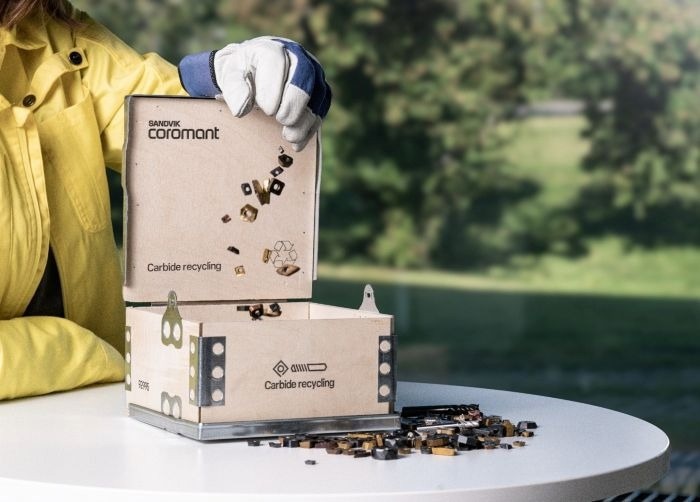Climate TRACE, an independent greenhouse gas emissions monitoring group, reported in April 2025 that in the first two months of 2025, total global emissions were 10.32 billion tonnes of carbon dioxide equivalent. A major contributor to emissions is industrial waste, most of which ends up in landfill. While recycling helps, it isn’t a complete solution. Here, Patrik Eurenius, Head of Sustainability and EHS at metal cutting expert Sandvik Coromant, explains how tool reconditioning offers an alternative solution.

Image Credit: Sandvik Coromant
Global waste levels are increasing rapidly, with the UN projecting municipal waste will reach 3.8 billion tonnes by 2050. Currently, 50% of all municipal waste comes from industrial waste. To prevent waste projections becoming a reality, and to curb global emissions, it’s essential to reduce industrial waste.
Cutting tools are vital to industries such as aerospace, automotive and oil and gas, where they endure extreme conditions such as high pressure, intense heat and abrasive materials. These harsh environments inevitably cause tools to wear out, and some manufacturers may possibly be inclined to replace them prematurely to avoid disruption.
But a tool’s life may not be over. With a proven reconditioning strategy, a single machine tool can be effectively used several more times.
Time to Sharpen Up
Tool reconditioning involves more than just simple resharpening. It is a precision-engineered, multi-step process designed to return a worn tool to its original geometry. In doing so, the tool's life is extended and the reliance on raw materials is minimized, enabling manufacturers to embrace tool technology to its full potential.
First, the worn tool goes through an extensive inspection. Advanced metrology equipment is used to evaluate wear patterns and the tool’s structural integrity. This includes spotting defects such as flaking, crated wear and chipping. This initial step is critical as it not only identifies the areas that need attention but also determines whether the tool is eligible for reconditioning.
If the tool is deemed suitable for reconditioning, regrinding begins. This is carried out using advanced CNC machines, which are used to restore the tool’s cutting edges and geometric profile within microns of the original specification. During this stage great care is taken to manage thermal loads and maintain precise alignment between the cutting edge and central axis of the tool body to avoid compromising the tool’s structural core.
Next, fresh coating is applied to enhance the tool's resistance to heat, abrasion and chemical wear. This is done through highly precise processes such as Physical Vapour Deposition (PVD) or Chemical Vapour Deposition (CVD) to ensure uniformity and optimal bonding. PVD processes are typically favored for high-precision tooling, as they operate at lower temperatures, which helps prevent thermal distortion.
After regrinding and coating, the reconditioned tool undergoes rigorous performance testing. This includes edge integrity analysis, coating adhesion evaluation or scratch testing and performance benchmarking against new tools. These tests mirror those applied to new tools and are designed to ensure that the reconditioned tool meets the original manufacturing standards for performance, quality and precision.
Once ready, the tools are cleaned and packed away in protective packaging to prevent damage during transit. They are then returned to the customer, ready for high-precision, high-efficiency reuse on the shop floor.
Beyond Tool Performance
Through its global network of reconditioning centers, Sandvik Coromant provides a comprehensive, end-to-end reconditioning service. Beyond tool performance, these centers are helping to drive a broader shift in manufacturing practices
In addition to its reconditioning centers, Sandvik Coromant also has its own recycling scheme for carbide tools that are worn past being able to be reconditioned. At their recycling plant in Austria, worn-out carbide tools are collected and turned back into new products. This process includes recovering critical resources, such as tungsten.
Due to its high melting point, strength and wear resistance, tungsten is a critical material in machine tooling, particularly of high-performance alloys, which are becoming increasingly common in aerospace and automotive manufacturing. However, the Earth’s remaining reserves of tungsten are only around 7 million tonnes, or 100 years of consumption. This makes Sandvik Coromant’s recovery process critical for not only reducing carbon footprints but sustaining the advancement of manufacturing.
Cutting industrial waste is essential to limiting emissions and meeting climate targets. Tool reconditioning helps manufacturers to rethink waste and move away from traditional consumption practices. Ultimately, this practice contributes to a more resource-efficient and environmentally resilient world.